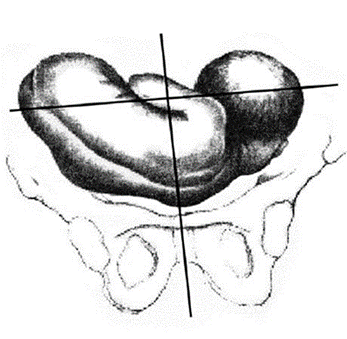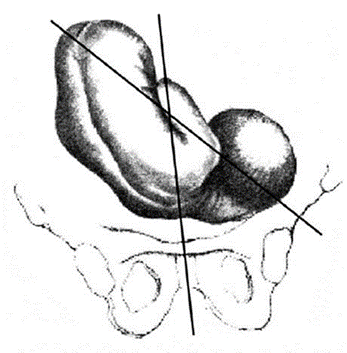 |
Management of labor with breech presentation
|
|
|
|
Bed rest is recommended to prevent preterm expulsion of fluids in the 1st stage of labor. The 1st stage of labor is conducted under constant cardiomonitoring (CTG). Evaluation of the fetal and maternal conditions, labor pains effectiveness and cervical dilatation rate is obligatory.
In the 2nd stage of labor manual assistance is provided depending on the type of breech presentation. With full dilatation of the cervix 5 IU of Oxitocin should be started IV to prevent weakness of expulsive pains (5 units of oxytocin + 400 mL of a 5% solution of glucose from 10-12 drops / minute not to exceed 40 drops / minute). The occurrence or suspicion of any complication is an indication for an emergency cesarean section in breech presentation.
Currently, pelvic presentation is considered pathological and in most countries they are an indication for cesarean section in a planned manner
Self Test
1. Which of the following describes a complete breech presentation best of all?
A. the legs and thighs of the fetus are flexed
B. the legs are extended and the thigs are flexed
C. the legs are flexed at knees while thighs are extended
D. the legs and thighs of the fetus are extended
2. Which of the following factors may be responsible for the breech presentation?
A. NVP in pregnancy
B. prematurity
C. the increased number of vaginal examination during pregnancy
D. maternal obesity
3. Auscultation of the fetal heart in breech prsentation is better:
A. above the umbilicus
B. below the umbilicus
C. below the costal margin
D. above the symphysis pubis
4. The fundal grip in breech presentation shows:
A. a large, globular, hard and ballotable part in the fundal area
B. an irregular, broad and soft part in the fundal area
C. absence of a part of the fetus in the fundal area
D. small parts of the fetus in the fundal area
5. During vaginal examination in breech presentation one can find:
A. an irregular presenting part without any sutures and fontanelle
B. a globular, hard and ballotable part
C. dorsal spine of the fetus
D. facial bones
6. The 1st moment of mechanism of labor in breech presentation (incomplete type) is:
A. engagement of the hips
B. the internal rotation of the hips
C. flexion of the hips
D. deflexion of the hips
7. The 2nd moment is:
A. engagement of the hips
B. the internal rotation of the buttocks
C. the internal rotation of the trunk
D. extension of the arms
8. The 3rd moment is:
A. crowning of the buttocks
B. the internal rotation of the buttocks
C. shoulders delivery
D. the external rotation of the trunk
9. The 4th moment is:
A. shoulders delivery
B. head delivery
C. expulsion of the trunk
D. the external rotation of the trunk
10. What is the main idea of Tsovyanov’s method № 1?
A. to expedite the fetus delivery
B. to retain the attitude of flexion of the fetus
C. to slow down the fetus delivery
D. to correct the biomechanism of labor
|
|
|
CHAPTER 18. TRANSVERSE AND OBLIQUE LYING OF THE FETUS
When the long axis of the fetus lies perpendicularly to the maternal spine or centralized uterine axis, it is called a transverse lie. (Fig. 146)

Fig. 146 Transverse lying of the fetus
When the fetal axis is placed obliquely to the maternal spine it is called an oblique lie. (Fig. 147).

Fig. 148. Oblique lying of the fetus
All those are abnormal, because spontaneous delivery through the natural ways is impossible.
The position of the fetus is determined by the direction of the head.
The position may be:
· 1st — when the head is directed to the left maternal side.
· 2nd — when the head is directed to the right maternal side.
The fetus back may be directed anteriorly (to the maternal abdominal wall) and is called an anterior type of position with transverse lie (dorso-anterior) (Fig. 149).

Fig. 149. Anterior type of position with transverse lie (dorso-anterior).
The fetus back may be directed to the maternal spine, it is called a posterior type of position (dorso-posterior). However, more commonly, fetus back is not exactly directed anteriorly or posteriorly. At the same time, it may be directed inferiorly (to the inlet) or superiorly (to the fundus of the uterus). Thus, there may be an antero-inferior or antero-superior type of position, and a posterior-inferior or posterior-superior one.
Terminology of the types of position of the fetus in transverse lying
1 – Dorsoanterior (the commonest, 60%)
2 – Dorsoposterior
3 - Dorsosuperior
4 – Dorso-inferior
Etiology
The causes of transverse and oblique lying of the fetus are the following:
· multiparity — lax and pendulous abdomen, imperfect uterine tone, etc;
· prematurity;
· multiple (plural) pregnancy, especially twins — it is more common that one fetus has a transverse lying and the second — a longitudinal one;
· hydramnios;
· contracted pelvis;
· placenta praevia;
· pelvic tumors;
· congenital malformation of the uterus — arcuate or subseptate;
· intrauterine death.
Diagnosis
Abdominal Examination
Inspection:
The uterus looks broader and often asymmetrical, not maintaining a piriform shape.
Palpation:
The fundal height is less than the period of amenorrhea;
The 1st and 3rd grips: the fetal pole (breech or head) is not palpable;
The 2nd grip: a soft broad and irregular breech is felt to one side of the midline and smooth, hard and globular head is felt on the opposite side.
The 4th grip: emptiness of the lower pole of the uterus. This, however, is commonly evident during pregnancy, but during labor the shoulder may occupy it.
Auscultation:
The fetal heart sound is heard at the level of umbilicus, on the right or left side depending on position.
|
|
|


